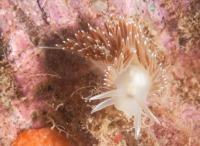
(Photo: Claire Goodwin)
Red-Gilled Sea Slug
Coryphella verrucosa
Sea slug with a transluscent white body. Adults are 20 to 35 millimetres in length. It has five to seven groups of red, light brown or maroon projections called cerrata. The cerrata have white tips. It has a white stripe along the centre of its tail.
Authority
(M. Sars, 1829)
Classification Details
Phylum: Mollusca (molluscs); Class: Gastropoda (gastropod molluscs, or snails and slugs).
Habitat
Usually found on or near its hydroid prey on areas of bedrock. Found from New England to Greenland on the east coast of Northern America. Also present in Iceland, Spitzbergen, Scandinavia, Barents and Kara Seas, and northern Pacific Ocean. In the Gulf of Maine, it is found down to depths of 33 metres. It occurs on the shore as well as in the subtidal zone.
Diet
Predator. Feeds on hydroids, including the pink hearted hydroid (Ectopleura crocea). In some areas, it also feeds on the benthic stages of sea jellies. When food is scarce it will also eat the colonial star ascidian (Botryllus schlosseri).
Reproduction
Hermaphrodite – individuals are both male and female. This species has an annual life cycle. Adults become sexually mature from March to July. Adults engage in a touching ritual before mating. They lay neat spirals of eggs on bedrock and hydroids. These hatch into planktonic veliger larvae. After a six to eight week larval phase, larvae settle on their hydroid prey. They then feed and grow over winter before reproducing in spring.
Fun Facts
This species (like other nudibranchs in this group) can incorporate stinging cells (nematocysts) from its prey into its cerrata (back projections). It adds more nematocysts when more predators are around.
Sea slugs lay different shaped egg masses. This species lays a thin string of eggs in a spiral. Other species can lay fat strings or ribbons. Looking for eggs can help determine what species are present - adults are often hard to spot!
References
de Kluijver MJ, Ingalsuo SS, de Bruyne RH (2000) Coryphella verrucosa. In: Mollusca of the North Sea. http://species-identification.org/species.php?species_group=mollusca&id=627 Accessed online 20 January 2020. Frick K (2003) Response in nematocyst uptake by the nudibranch Flabellina verrucosa to the presence of various predators in the Southern Gulf of Maine. Biological Bulletin 205, 367–376. doi:10.2307/1543299 Kuzirian AM (1979) Taxonomy and biology of four New England coryphellid nudibranchs (gastropoda: opisthobranchia). Journal of Molluscan Studies 45, 239–261. Picton BE and Morrow CC (1994) A field guide to the nudibranchs of the British Isles. London: Immel Publishing Ltd.

